Congee
This article needs additional citations for verification. (April 2011) |
| Type | Porridge |
|---|---|
| Main ingredients | Rice |
Congee (/ˈkɒndʒiː/, derived from Tamil கஞ்சி [kaɲdʑi])[1][2][3] is a form of savoury rice porridge made by boiling rice in a large amount of water until the rice softens. Depending on rice-water ratio, the thickness of congee varies from a Western oatmeal porridge to a gruel. Since the history of rice cultivation in Asia stretches back to the Baiyue-inhabited lower Yangtze circa 10000 BC,[4][5][6] congee is unlikely to have appeared before that date. Congee is typically served with side dishes, or it can be topped with meat, fish and pickled vegetables.
Vivid experiences of eating or delivering thin congee as wartime or famine food often feature in diaries and chronicles.[7] In some cultures, congee is eaten primarily as a breakfast food or late supper; some may also eat it as a substitute for rice at other meals. It is often considered suitable for the sick as a mild, easily digestible food.[8]
Etymology
The popular English name Congee derives from the Tamil word கஞ்சி (kañci). The Portuguese adopted the name as canje, with the first document mentioning the dish and the word in 1563. The English name was adopted from the Portuguese.[9] In China, congee is known as zhou (Chinese: 粥; pinyin: zhōu; Cantonese Yale: jūk), with the first recorded reference traced back to 1000 BC during Zhou dynasty. Across Asia, various similar dishes exists with varying names.
Varieties
East Asia
China
By porridge (粥 or 稀飯), Chinese languages across the south usually mean rice porridge, while in the north it may refer to cornmeal porridge, proso millet porridge, foxtail millet porridge, or sorghum porridge, reflecting the north–south divide of grain production.
In northwest Shanxi and Inner Mongolia, fermented rice and millet porridge known as 酸粥 (Jin Chinese: [suɤ tʂɑo]) is popular. Rice and millet are soaked to allow fermentation, then water is emptied to obtain porridge. The emptied water is served as a drink called 酸米湯 (Jin Chinese: [suɤ mi tʰɤu]). The porridge is eaten alongside pickles, e.g. turnips, carrots, radish and celery. The porridge may be stirred-fried and is called 炒酸粥 ([tsʰo suɤ tʂɑo]). The porridge may also be steamed into solids known as 酸撈飯 ([suɤ lo fã]). While the traditional grain is proso millet, it is mixed with rice when available. Many folk idioms of sourness derive from this dish.[10][11][12][13][14][15]
In Shanghai, Suzhou and nearby, an iconic glutinous rice porridge topped by red bean paste, sweet olive syrup and brown sugar is called 赤豆糊糖粥 (Wu Chinese: [tsʰaʔ dɤ ɦu dɑ̃ tsoʔ]).[16][17] Street hawking of this porridge is featured in a well-known Wu Chinese nursery rhyme.[18][19][20]
Originated in Guangdong, the century egg congee peidaansaujuk zuk (Cantonese: 皮蛋瘦肉粥) has become a nationwide hit since the 2000s. It was first tested on the menu of KFC in Shanghai in 2002 and later rolled out to all KFCs in mainland China and Taiwan.[21][22] In 2020, the online food ordering company Ele.me revealed century egg porridge ranked top ten in breakfast orders in almost every Chinese major city as far north as Harbin.[23][24]
Common regional ingredients go into congee not mentioned above include
Taiwan
In Taiwan, congee is known as 糜 [mí] in Taiwanese Hokkien, or 稀飯 [xīfàn] in Taiwanese Mandarin. Sweet potato, taro root, or century egg is often added for taste. A famous congee dish in Taiwan is the milkfish congee.[citation needed]
Japan

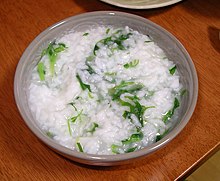
Kayu (粥), or often okayu (お粥) is the name for the type of congee eaten in Japan,[25] which typically uses water to rice ratios of 5:1 or 7:1 and is cooked for about 30 minutes.[citation needed]
Kayu may be made with just rice and water, and is often seasoned with salt.
In Japan porridge – because it is soft and easily digestible – is regarded as a food particularly suitable for serving to the sick and elderly.[26] For similar reasons kayu is commonly the first solid food served to Japanese infants; it is used to help with the transition from liquids to normally cooked rice, the latter being a major part of the Japanese diet.
A type of kayu referred to as
Kayu is also used in Shinto divination rituals.[28]
Korea
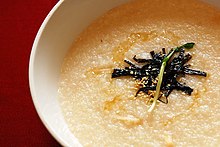

Juk (죽; 粥;
Depending on the ingredients and consistency, juk can be considered as food for recuperation, a delicacy, or famine food.[30] It is known to have nutritional benefits, and is considered to be beneficial to digestion because of its soft texture. It is a staple "get well" dish; a dish to eat when one is sick or recovering from bad health.[31] Juk is also considered an ideal food for babies, the ill or elderly, as it is easily eaten and digested.[32] It is also sold commercially by many chain stores in South Korea, and is a common takeout dish.[33]
There are more than forty varieties of juk mentioned in old documents.[30] The most basic form of juk, made from plain rice, is called ssaljuk (쌀죽; 'rice porridge') or huinjuk (흰죽; 'white porridge'). Being largely unflavored, it is served with a number of more flavorful side dishes, such as jeotgal (salted seafood), various types of kimchi, and other side dishes.[citation needed]
Notable varieties include
Varieties of juk include:
- Daechu-gom (대추곰) – jujube porridge
- Dakjuk (닭죽) – chicken porridge
- Euneo-juk (은어죽; 銀魚粥) – sweetfish porridge
- Heugimja-juk (흑임자죽; 黑荏子粥) – black sesame porridge
- Hobak-juk (호박죽) – pumpkin porridge
- Jangguk-juk (장국죽) – beef porridge
- Jatjuk (잣죽) – pine nut porridge
- Jeonbok-juk (전복죽; 全鰒粥) – abalone rice porridge
- Patjuk (팥죽) – red bean porridge
- Tarak-juk (타락죽; 駝酪粥) – milk porridge.
Southeast Asia
Myanmar
In Myanmar, congee is called hsan byoke or hsan pyoke, literally "(uncooked) rice boiled". It is plain porridge, often made with just rice and water, but sometimes with chicken or pork stock and served with a simple garnish of chopped spring onions and crispy fried onions.[citation needed]
Cambodia

In Khmer, congee is called babor (បបរ). It is one of the options for breakfast along with kuyteav, another popular Cambodian breakfast dish.[34][35] Congee is eaten throughout Cambodia both in the countryside and in the cities.
Congee can be eaten plain or with a variety of side dishes and toppings such as soy sauce, added to enhance taste, as well as dried salted fish or fried breadsticks (ឆាខ្វៃ, cha kway).[36]
There are two main versions of congee: plain congee, and chicken congee (បបរមាន់, babor mŏən). It is usually eaten during the colder dry season or when someone is sick. After the congee is prepared a variety of toppings can be added to enhance the flavour such as bean sprouts, green onions, coriander, pepper, along with the dried fish and fried breadsticks on the side. The chicken congee is the same as plain congee but contains more herbs and chicken.[37][38]
Indonesia

In Indonesia, congee is called bubur, and it is a popular breakfast food.[39][40] Travelling bubur ayam vendors frequently pass through residential streets in the morning selling the dish.[39][41] A popular version is bubur ayam, which is congee with shredded chicken meat. It is also served with many condiments, such as green onion, crispy fried shallot, fried soybean, Chinese crullers (youtiao, known as cakwe in Indonesia), both salty and sweet soy sauce, and sometimes it is topped with yellow chicken broth and kerupuk (Indonesian style crackers). Unlike some other Indonesian dishes, it is not spicy; sambal or chili paste is served separately.
Some food vendors serve
On the north coast of Bali, famously in a village called Bondalem, there is a local congee dish called mengguh, a popular local chicken and vegetable congee that is spicier than common bubur ayam and more similar to tinutuan, using a spice mix of onions, garlic, coriander seeds, pepper and chili.[42]
In another region of Indonesia, the city of
In the eastern parts of Indonesia, the local congee is called
Laos
In
Malaysia
In Malaysia, congee is known as porridge or bubur.
Philippines
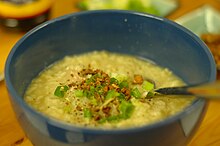
Lugaw (pronounced Tagalog pronunciation: [ˈluɡaw]) is the Filipino generic term for rice gruel.[note 1][45] It encompasses a wide variety of dishes, ranging from savory dishes very similar to Chinese-style congee to dessert dishes. In the Visayan regions, savory lugaw are known as pospas. Lugaw typically use glutinous rice (Tagalog: malagkit; Visayan: pilit). It is usually thicker than other Asian congees, retaining the shape of the rice, yet with a similar texture.
Savory versions of lugaw are flavored with
Dessert versions of lugaw include champorado (lugaw with home-made chocolate topped with milk), binignit (lugaw in coconut milk with various fruits and root crops), and ginataang mais (lugaw with sweet corn and coconut milk), among others. Like the savory versions, they are usually eaten for breakfast, but can also be eaten as a snack. In Hiligaynon-speaking areas, lugaw may refer to binignit.
Singapore
In Singapore, Teochew porridge or Singapore-style porridge is a version of Singapore congee.[48] In Singapore, it's considered a comfort food for both breakfast and supper. Teochew porridge dish often accompanied with various small plates of side dishes.[48] Usually, it's served as a banquet of meats, fish egg and vegetables eaten with plain rice porridge. The recipes that early immigrants prepared in Singapore have been modified over the generations to suit local tastes. Singapore Teochew style porridge is usually consumed with a selection of Singaporean Chinese side dishes like Nasi Padang. There is no fixed list of side dishes, but in Singapore, accompaniments typically include lor bak (braised pork), steamed fish, stir-fried water spinach (kangkong goreng), salted egg, fish cake, tofu, omelette, minced meat, braised tau kway, Hei Bee Hiang (fried shrimp chilli paste), and vegetables.[49]
Thailand


In
Plain congee, known as khao tom kui (
Notable Jok eateries in Bangkok can be found in areas like
In a popular reference within the 2011 US comedy film The Hangover Part II set in Thailand, Jok is described as being a food for ″small babies and very old people″ with ″no taste″ that is nourishment ″everybody can digest″. The reference is used to describe the character of the protagonist Stu Price (portrayed by Ed Helms).
Vietnam
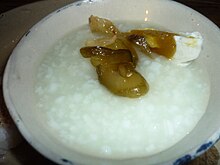
In Vietnam, congee (Vietnamese: cháo)[56] is sometimes cooked with pandan leaves or Asian mung bean. In its simplest form (plain rice porridge, known as cháo hoa),[57] it is a food for times of famine and hardship to stretch the rice ration. Alternately, as is especially common among Buddhist monks, nuns and lay persons, it can be a simple breakfast food eaten with pickled vegetables or fermented tofu (chao).
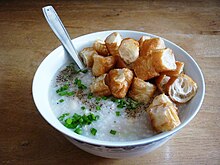
Despite its ubiquity among the poor, it is also popular as a main dish when cooked with a variety of meats. For example, cháo gà is cooked with chicken, garlic, and ginger. The rice porridge is cooked in chicken broth, and when the chicken is cooked, the meat is sliced and layered on a bed of shredded raw
Cháo bầu dục is a congee containing pig
Youtiao is usually added to congee especially at congee vendors.
It is also common to eat cháo when ill, as it is believed the porridge is easy to digest while being fortifying. For such purposes, the cháo is sometimes cooked with roasted white rice, giving the porridge broth a more nuanced body and a subtle, nutty flavor. In some parts of Vietnam, local customs call for making cháo as offerings for the "wandering souls" during the Buddhist Vu Lan summer feast.
South Asia
India
Tamil Nadu
Kanji is a popular dish in the state of Tamil Nadu. Among the working classes, it is a staple nourishing breakfast dish, although consumed often for lunch and dinner as well. In addition, all classes regard kanji as an excellent food during convalescence, for its ability to be easily digested. The different kinds of kanji in Tamil Nadu includes rice kanji (the most popular): variations of this include sweet rice kanji (milk and sugar/jaggery added to the cooked rice soup) or salt rice kanji (buttermilk and salt added to the rice soup); wheat kanji, mung bean kanji, ragi/millet kanji, multi-grain kanji.
Karnataka
In
Konkan
In the Konkan region of India, congee is known as pez, is a home remedy for treating a fever as it is easy to digest. The farming and manual labour community of the same region, on the other hand, consume on a daily basis in the late morning as a source of energy. Variants of the dish include nachnyachi pez (ambil) which is made with ragi and rice, athwal or metheachi pez is a sweeter version which is made with rice, fenugreek and jaggery, which is usually served to a nursing mother. The rice here is usually eaten boiled, with dry fish, vegetables or pickles.[66]
Western Karnataka and Goa
In
Kerala
In the state of
Poor households of Kerala used to re-cook leftover rice and all available leftover curries into congee water and take as a mix-mash dish known as pazhamkanji (old congee).[68]
Pazhamkanji means old congee (leftover from the previous day). It is not necessarily eaten by poor people, neither it is necessarily re-heated with leftover curries.
According to the Indian writer Madhur Jaffrey, kanji is, or derives from, a Tamil word for "boiling"—which refers to the porridge and also to any water in which rice has been cooked.[citation needed]
Muslims of south India especially
Andhra Pradesh
In the state of Andhra Pradesh, it is called ganji in Telugu. Ganji is made by boiling rice in large amounts of water and then the filtered liquid is known as Ganji. Ganji mixed with buttermilk is believed to add to the flavor, and is also suggested by doctors for patients with ailing health.
Odisha
Kaanji is a traditional
In the Buddhist Yāgu Sutta of the Aṅguttara Nikāya (AN 5.207), the Buddha recommends eating rice porridge, "yāgu": "There are these five benefits in rice porridge. What five? It stills hunger, dispels thirst, settles wind, cleans out the bladder, and promotes the digestion of the remnants of undigested food. These are the five benefits of rice porridge.".[69]
Sri Lanka
In
Most of the time, kiriya, kurakkan kenda, sawu kenda, pol kiri kenda and kitul piti kenda are used as sweets. Sugar, candy, dates, raisins, cashew nut, jaggery, and treacle are among the ingredients that may be added to sweeten these congees.
Congee is also eaten by
The Americas
Caribbean Tamil Community
Among the
Europe
Portugal
In
Hungary
In Hungary it is called rizskása, a traditional Hungarian food in the Hungarian population of Upper-Hungary(today Slovakia) and is also used as strudel filling.
See also
Notes
References
- ^ "Definition of CONGEE". www.merriam-webster.com. 22 July 2023.
- ^ Yule, Henry, Sir (1903). Hobson-Jobson: A glossary of colloquial Anglo-Indian words and phrases, and of kindred terms, etymological, historical, geographical and discursive.
It is from the Tamil kanjī, 'boilings.'
{{cite book}}: CS1 maint: multiple names: authors list (link) - ^ Lim, Lisa (10 November 2017). "Where the word congee comes from – the answer may surprise you". Post Magazine. South China Morning Post. Retrieved 22 August 2021.
- S2CID 162414736.
- PMID 24753573.
- PMID 30507965.
- ^ 陳嘉遠 (July 2021). "一個愛國知識份子的流亡生涯——陳嘉遠先生日記(1950.9.1-9.30)". 黃花崗雜誌. No. 70–71. p. 65.
- ^ Robert Saunders (1789) "Boutan & Thibet", Philosophical Transactions of the Royal Society Vol. 79, p. 101
- ^ Lim, Lisa (10 November 2017). "Where the word congee comes from – the answer may surprise you". South China Morning Post.
- ^ 赵喜荣 (5 June 2023). "东拉西扯唠酸粥(二)". 府谷故事. 府谷县委史志研究室. Archived from the original on 27 August 2023.
- ^ 若希 (29 November 2022). "可口的烂腌菜". 鄂尔多斯日报. p. 6. Archived from the original on 25 August 2023.
- ^ 杜洪涛 (7 November 2022). "准格尔的酸味" (PDF). 內蒙古日報. Archived from the original (PDF) on 21 August 2023.
- ^ 魏二保; 王二永 (18 January 2018). "府谷酸捞饭、酸稀粥、酸米汤,只属于我们府谷人的味道". 府谷报. 府谷县融媒体中心.
- ^ 闫桂兰 (13 January 2019). "准格尔的酸粥!口水直流". 右读 – via 准格尔旗发布.
- ^ 邢向东; 王兆富 (2014). 吴堡方言调查研究. 中华书局. pp. 43, 44, 48, 51, 61, 150.
- ^ "桂花赤豆汤粥,甜得讲究". 三联美食. Beijing: 三联生活. Archived from the original on 27 August 2023.
- ^ 钱乃荣 (2007). 上海话大词典 (PDF). 上海辞书出版社. pp. 49, 56. Archived from the original (PDF) on 7 April 2021.
- ^ 予安老师, "音频". In 更苏州, ed. (3 August 2018). "笃笃笃,卖糖粥……小辰光,我们常哼的童谣,你还记得吗?".
- ^ 郑土有; 王士均 (2006). 笃笃笃,卖糖粥——100首上海里弄童谣 (附光盘). 华东师范大学出版社. Archived from the original on 28 August 2023.
- ^ 冯大诚 (16 April 2012). "闲说苏州(7)旧时街头交响(上)". 科学网. Archived from the original on 31 August 2023.
- ^ 周锡娟 (9 December 2022). "肯德基大打"本土"牌 金针鸡丝汤月底上市". 江南时报. Wuxi – via Sina.
- ^ 草梅 (30 March 2005). "乱弹东西(十六): 肯德基的皮蛋瘦肉粥和麦当劳的金牌饮料". e-yep.com. Archived from the original on 28 August 2023.
- ^ 严珏 (21 August 2020). "中国人的早餐藏着什么秘密". 网易数读. Archived from the original on 22 August 2020.
- ^ 饿了么 (20 January 2018). 2017年中国互联网本地生活服务蓝皮书. 饿了么. Archived from the original on 22 August 2023.
- ^ "Okayu recipe". about.com. Archived from the original on 28 January 2007. Retrieved 2 May 2007.
- ISBN 9781458769589. Retrieved 24 November 2012.
- ISBN 9784770020888. Retrieved 24 November 2012.
- S2CID 131527379. Retrieved 14 February 2017.
- ^ ISBN 978-8985846981.
- ^ a b (in Korean) Juk Doosan Encyclopedia
- ^ "Rice porridge (Juk) A Practical source of nutrition" Archived 17 March 2012 at the Wayback Machine Paik Jae-Eun, professor of food and nutrition, Bucheon College, 2008 Spring Koreana. Retrieved 2010-06-16
- ^ (in Korean)"Food industry eyes baby market", Newsis Health 2010-03-30
- ^ "Busy juk restaurants" (in Korean). City News. 17 May 2010. Archived from the original on 12 January 2012. Retrieved 8 June 2010.
- ^ Goldberg, Lina. "How Breakfast Has Shaped Cambodia's Cultural Identity". BBC. The New York Times. Retrieved 30 June 2018.
- ^ Jimmy (3 March 2014). "The Cambodian Breakfast". Jimmy Eats World.
- ^ lov, lisa (September 2015). "Congee – Asian Rice Porridge". aorta food.
- ^ Larson, Tevy (25 February 2013). "Chicken Rice Congee (Khmer Borbor Sach Mouan)". Tevys Food Blog. blogspot.
- ^ Smith, Joanne. "BUILD YOUR OWN Cambodian Chicken Rice Soup". The Family Dinner Project.
- ^ ISBN 978-1-59884-955-4. Retrieved 11 August 2017.
- ISBN 978-1-78023-121-1. Retrieved 11 August 2017.
- ISBN 978-979-461-689-5. Retrieved 11 August 2017.
- ^ indonesiasecretkitchen. "Indonesia Secret Kitchen: Bubur Mengguh recipe". Indonesiasecretkitchen.blogspot.nl. Retrieved 24 November 2012.
- ISBN 978-1-4422-6804-3. Retrieved 11 August 2017.
- ISBN 978-0-19-551450-6. Retrieved 11 August 2017.
- ISBN 978-1-4387-7532-6. Retrieved 11 August 2017.
- ^ "The difference between lugaw, goto, and arroz caldo". 13 June 2018.
- ISBN 978-1-4629-1689-4.
- ^ ISBN 978-0-241-27877-2. Retrieved 11 August 2017.
- ^ "Enjoy Teochew porridge with popular dishes" (PDF). Archived from the original (PDF) on 9 October 2016. Retrieved 2 February 2016.
- ISBN 978-1-62315-650-3. Retrieved 11 August 2017.
- ^ "Jok Prince". Michelin Guide.
- ^ ร้านโจ๊ก ตลาดน้อย เจ๊หมวยเกี้ย ย่านเยาวราช. Chinatownyaowarach (in Thai).
- ^ "เจ๊เกียง โจ๊กกองปราบ" อร่อยอุ่นท้อง ได้ตลอด 24 ชั่วโมง. Manager Daily (in Thai). 2 July 2017. Archived from the original on 23 March 2018. Retrieved 23 March 2018.
- ^ ครัวคุณต๋อย: ขาหมูต้มถั่ว ร้านข้าวต้มแปลงนาม. Channel 3 (in Thai). 18 March 2018.
- ^ ร้านข้าวต้ม 3/1. Chinatownyaowarach (in Thai).
- ISBN 978-0-7627-9949-7. Retrieved 11 August 2017.
- ISBN 978-1-4629-1417-3. Retrieved 11 August 2017.
- ^ "Cánh Đồng Hoang quán – một điểm đến thú vị". Kenh14.vn. VC Corp. 1 December 2010. Retrieved 13 October 2013. (Originally in Pháp luật & Xã hội.)
- ISBN 978-0393249347.
- ^ Yule, Henry, Sir (1903). Hobson-Jobson: A glossary of colloquial Anglo-Indian words and phrases, and of kindred terms, etymological, historical, geographical and discursive.
It is from the Tamil kanjī, 'boilings.']
{{cite book}}: CS1 maint: multiple names: authors list (link) - ^ Staff Reporter (19 August 2012). "NATIONAL / TAMIL NADU : Minister moots heritage tourism plan for Jawadu Hills". The Hindu. Retrieved 24 November 2012.
- ^ Shonali Muthalaly (11 June 2010). "Life & Style / Food : The Reluctant Gourmet – Back to the basics". The Hindu. Retrieved 24 November 2012.
- ^ Syed Muthahar Saqaf (8 April 2012). "NATIONAL / TAMIL NADU : Desi version of porridge sold like hot cakes". The Hindu. Retrieved 24 November 2012.
- ^ Anushree Shetty (September 2015). "Ganji". Retrieved 17 March 2023.
- ^ udupi-recipes. "Coconut Milk Rice Porridge, Ganji". Retrieved 16 March 2023.
- ^ Gauree Malkarnekar | TNN (16 October 2016). "'Pez' soothes the fever and the brow" (Newspaper article). The Times of India. Retrieved 29 June 2017.
{{cite web}}: CS1 maint: multiple names: authors list (link) CS1 maint: numeric names: authors list (link) - ^ "Payaru Kanji with Thenga Chammanthi ~ SarasYummyBites". SarasYummyBites. 15 April 2014. Retrieved 11 August 2017.
- ISBN 978-81-85938-99-8. Retrieved 11 August 2017.
- ^ "5:21 Kimbilavaggo - English". awake.kiev.ua.
- ISBN 978-955-96843-0-5. Retrieved 11 August 2017.
- ^ "Appetizing kenda to titillate Royalists' tastebuds". The Island. 11 August 2017. Retrieved 11 August 2017.
External links
- Chicken Congee. NYT Cooking.

